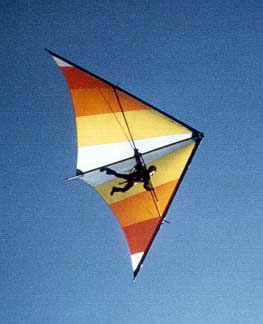The Physics of Hang Gliding

Photo courtesy of: All about Hang Gliding
By Nathan EarlsUniversity of Alaska Fairbanks
Web Project for Physics 211Fall 2002
Welcome
to my web page on hang gliding. My intent is to show you how and why
hang gliders work. But first a little background knowledge on hang gliders
is nice. Hang gliders have been around since the the 1800's, though
the concepts of flight were not fully understood then, and very few, if any
successful flights were made. They began to be practically used around
the 1950's as a branch off of American aerospace research. These first
designs were known as parawings, and were developed by Francis and Gertrude
Rogallo. Early gliders had wooden or bamboo frames and polythene sails,
which is primitive when compared to the new materials used in today's gliders,
which will be discussed in further detail later. These gliders intrigued
people then just as they do today because the concept of free flight is often
an exciting idea. Nearly everyone (except those with an intense fear
of heights) have dreamed at one time or another of being able to soar above
the earth. Hang gliding is about the closest we can come to free flight,
no motor or source of thrust involved, only you and the open sky.
To understand how hang gliders work, you have to first understand the forces that act on a glider in flight. There are three of these forces, they are: lift, drag, and gravity. In order for the glider to fly, the lift force must overcome the drag and gravity forces. This is explained in further detail in the next pages.
To understand how hang gliders work, you have to first understand the forces that act on a glider in flight. There are three of these forces, they are: lift, drag, and gravity. In order for the glider to fly, the lift force must overcome the drag and gravity forces. This is explained in further detail in the next pages.